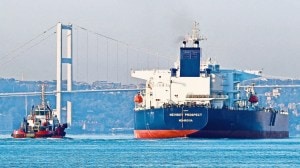USA: The Make Nothing Nation?
It seems like that the country that used to make everything is on the brink of making nothing.
It seems like the country that used to make everything is on the brink of making nothing.
In January,207,000 US manufacturing jobs vanished in the largest one-month drop since October 1982. Factory activity is hovering at a 28-year low. Even before the recession,plants were haemorrhaging work to foreign competitors with cheap labour. And some companies were moving production overseas.
But manufacturing in the United States isn’t dead or even dying. It’s moving upscale,following the biggest profits,and becoming more efficient,just like Henry Ford did when he created the assembly line to make the Model T car.
The United States by far remains the world’s leading manufacturer by value of goods produced. It hit a record $1.6 trillion in 2007 – nearly double the $811 billion in 1987. For every $1 of value produced in China’s factories,America generates $2.50.
So what’s made in the USA these days?
The US sold more than $200 billion worth of aircraft,missiles and space-related equipment in 2007. And $80 billion worth of autos and auto parts. Deere & Co.,best known for its bright green and yellow tractors,sold $16.5 billion worth of farming equipment last year,much of it to the rest of the world. Then there’s energy products like gas turbines for power plants made by General Electric,computer chips from Intel and fighter jets from Lockheed Martin. Household names like GE,General Motors,IBM,Boeing and Hewlett-Packard are among the largest manufacturers by revenue.
Several trends have emerged over the decades:
– America makes things that other countries can’t. Today,”Made in USA” is more likely to be stamped on heavy equipment or the circuits that go inside other products than the TVs,toys,clothes and other items found on store shelves.
– US companies have shifted toward high-end manufacturing as the production of low-value goods moves overseas. This has resulted in lower prices for shoppers and higher profits for companies.
– When demand slumps,all types of manufacturing jobs are lost. Some higher-end jobs – but not all – return with good times. Workers who make goods more cheaply produced overseas suffer.
Once this recession runs its course,surviving manufacturers will emerge more efficient and profitable,economists say. More valuable products will be made using fewer people. Products will be made where labour and other costs are cheaper. And manufacturers will focus on the most lucrative products.
Aircraft maker Boeing announced last month it was cutting about 10,000 jobs. At the same time,workers are streamlining the wing assembly for the 737,the company’s best-selling commercial plane,said Richard McCabe,a wing line mechanic for 10 years and former Machinists union shop steward.
He and his co-workers at the factory in suburban Renton,Washington,were asked about 3 1/2 years ago to figure out how to switch from building wings in massive stationary jigs mounted vertically,”the way things have been done here forever,” to “one-piece flow,” assembling them horizontally on a moving line similar to automobiles. The new process is set to begin by the end of the year.
“I won’t go to the wing. The wing will come to me,” McCabe said. “It’s going to save them millions in scrap and rework.”
McCabe said there was a lot of initial resistance on the shop floor,but Boeing’s increased outsourcing – including wing production for the new 787 to Japan – helped change workers’ minds.
“I told the guys,it’s development or die,” McCabe said. “If we can get this done,it assures us the future.”
About 12.7 million Americans,or 8 per cent of the labour force,still held manufacturing jobs as of last month. Fifty years ago,14.6 million people,or 28 per cent of all workers,toiled in factories. The numbers – though painful to those who lost jobs – show how companies are making more with less.
Still,the perception of decline is likely to grow as factories and jobs vanish,and imports rise for most goods we buy at stores.
Thirty years ago,US producers made 80 per cent of what the country consumed,according to the Manufacturers Alliance/MAPI,an industry trade group. Now it’s around 65 per cent.
American factories still provide much of the processed food that Americans buy,everything from frozen fish sticks to cans of beer. And US companies make a considerable share of the personal hygiene products like soap and shampoo,cleaning supplies,and prescription drugs that are sold in pharmacies. But many other consumer goods now come from overseas.
In the 1960s,America made 98 per cent of its shoes. It now imports more than 90 per cent of its footwear. The iconic red Radio Flyer wagons for kids are now made in China. Even Apple Inc.’s iPod comes in box that says it was made in China but “designed in
California.”
“Some people lament the loss of manufacturing jobs we could have had making iPods. So what?” said Dan Ikenson,associate director of the Center for Trade Policy Studies at the libertarian-leaning Cato Institute. “The imports of iPods support US jobs,” including engineers,marketers and advertisers.
Some US-made products are hiding in plain sight.
Berner International Corp.,based outside Pittsburgh,doesn’t make the clothes,dishes or sponges sold at Wal-Mart,but its products hang above shoppers’ heads as soon they come through the sliding doors.
The company’s 60 employees make air curtains rectangular blowers mounted to the ceiling that keep out hot or chilly air,insects and dust while keeping in air conditioning and heat. Also called air doors,they hang from ceilings at Wal-Marts,Whole Foods supermarkets and Starbucks,and above the big factory doors at Ford and Toyota car plants.
Chief executive Georgia Berner keeps her company in the United States because she relies on her staff’s deep knowledge of air blowers,which are custom made for clients using metal plates,fans,motors and electronic parts assembled at the company’s 60,000-square-foot factory. Each box requires specific voltages and sizing,she says.
“I have a crew here (with) much of the product knowledge in (their) heads,” she said.
To deal with the recession,her production manager is making the factory more efficient by move shelves of parts closer to workers.
She’s also banking on a new line of air curtains for fast food drive through windows,noting that fast food demand is on the rise while other restaurants decline.
Other companies saddled with high labour costs – sometimes called legacy costs that insured workers high wages,pensions and handsome benefits – can struggle to survive.
In the early 1980s,the US steel industry faced such pressure. Today,it’s the auto industry,which is pressuring its unions to agree to deep reductions in pay and generous benefits. In fact,it’s a condition of the $17.4 billion in emergency loans from the government to keep the industry in business.



- 01
- 02
- 03
- 04
- 05




























